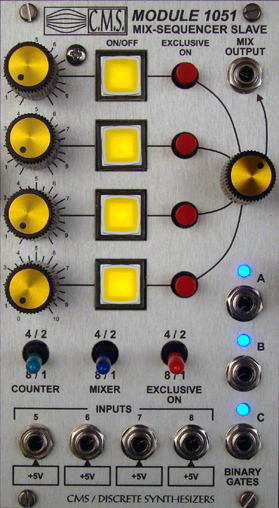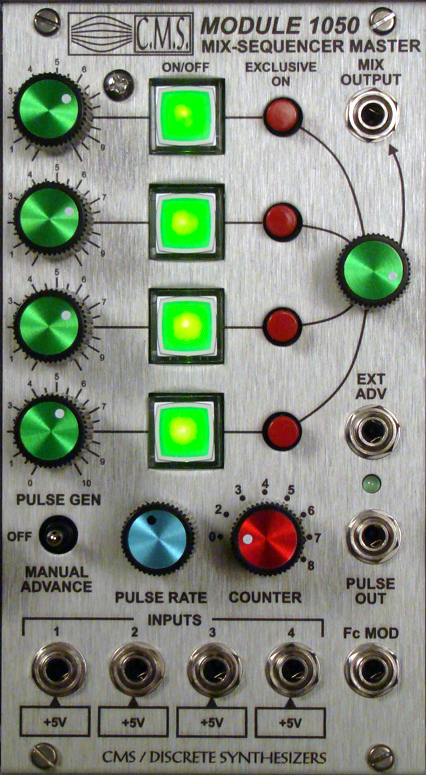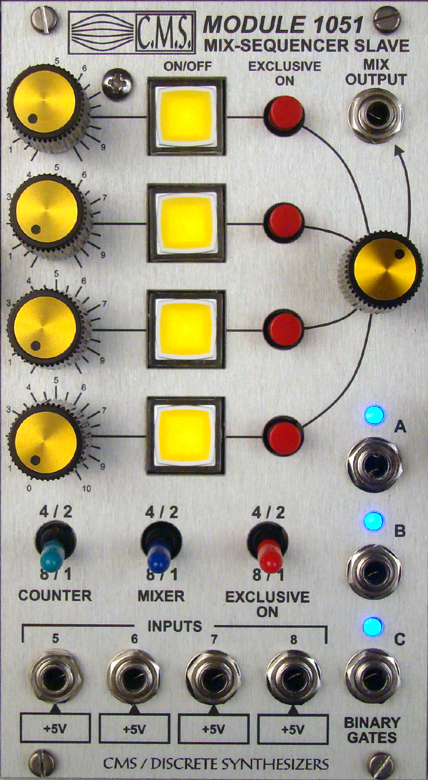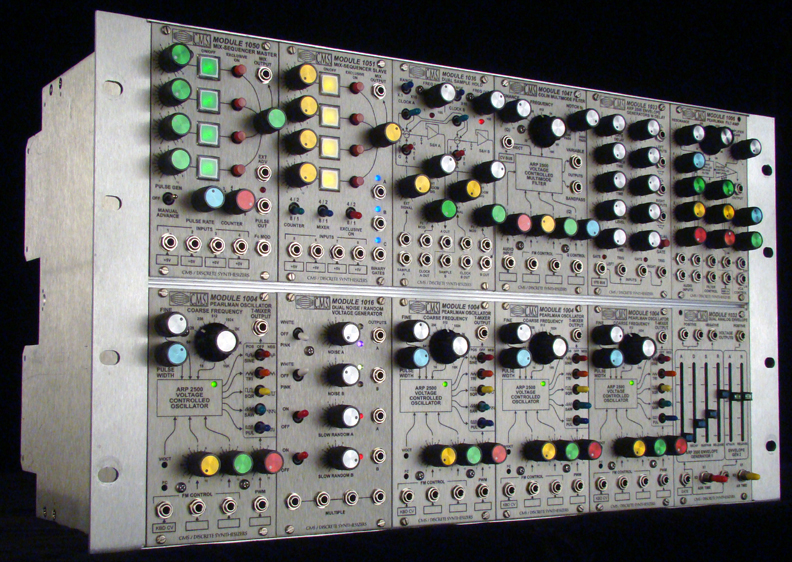
1050 MIX-SEQUENCER MASTER
1051 MIX SEQUENCER SLAVE


The CMS Module 1050 Mix-Sequencer Master and 1051 Mix-Sequencer Slave are multifunctional circuit packages designed for use with the CMS Series 1000 Modules. The modules incorporate sequential switching functions necessary for rapid selection of preset waveforms and signals into a conventional audio mixer format.
Module 1050 contains a four-input mixer with electronically gated inputs, an eight step counter and clock, and associated logic and switching circuitry. Each input has its own attenuator and each output has a master gain control. It can be used as a stand alone 4 channel Mix-Sequencer or it can be expanded to 8 channels using the 1051.
Module 1051 contains a four-input mixer with electronically gated inputs, associated logic and switching circuitry and selector switches that program the interaction between the 2 modules. Each input has its own attenuator and each output has a master gain control. It is designed to be an expander for the 1050 but it can be used as a stand alone 4 x 1 mixer.
The combination of CMS Modules 1050 and 1051 may be used as an eight input mixer with two adjustable outputs or as two separate four input mixers. A toggle switch on the 1051 module couples the audio circuitry to provide either the 1 x 8 or two 1 x 4 mixer configurations.
A column of illuminated push-buttons indicates which inputs are gated on. The switches are pushed to change the state of an input, push-on/push-off.
A column of "Exclusive-on" push-buttons will turn on a particular input while simultaneously turning all others off. This function is particularly useful for quick and convenient selection of preset signals.
The "Counter" toggle switch on the 1051 module indicates how the switching logic function between the 2 modules interact. In the lower position, the sequencer function of the circuit functions as one eight step sequencer. In the upper position, the logic functions as two 4 step sequencers. This mode is also refered to as "parallel step" operation as it permits the 1050 and 1051 sets of four inputs to be sequenced in tandem. In other words, the counter would actuate inputs in pairs: (1,5), (2,6), (3,7), (4,8).
With the "Mixer" switch on the 1051 in the upper position, the mixer circuitry is arranged as if the modules were two separate four-input mixers. In the lower position both modules function as a 8 x 1 mixer that will mix and sequence audio as well as voltages.
The "Exclusive on" toggle switch on the 1051 determines how the "Exclusive on" buttons function. When it is set to the lower setting the "Exclusive-on" button will affect all eight inputs. In the upper position, the function is separated between the 2 modules."Exclusive-on" switches will affect either the 1050 or 1051 of four inputs without interaction between modules.
In addition to the manual switching operations described in the preceding paragraphs, the Module 1050 contains a clock pulse generator and an eight step counter. A toggle switch at the lower left of the panel enables or disables the clock. When this switch is in the "Pulse Gen" position, the counter will sequentially enable inputs to the mixer (and illuminate the appropriate indicator lamps) one at a time, resetting at the end of every cycle. The length of the cycle, i.e., the number of counts in a cycle, is determined by the rotary switch at the center of the panel. Setting this switch to the "off" position disables the counter. The stepping rate is adjusted by the "pulse rate" control. The counter may be manually advanced by either the front panel toggle switch or an External Advance pulse.
The outputs of the counter or the front panel pushbuttons can actuate a mixer input. Inputs can be held on by setting the appropriate push-buttons even though the counter may be operating.
Unlike the original ARP module, each input jack on the 1050 and 1051 is "normalled" or pre-patched to a regulated DC voltage source. This enables the user to easily sequence voltages just like a normal 8 step sequencer. By inserting a jack into one of the input jacks, you can substitute or override the internal DC voltage source with any external source including audio sources.
Important note: This prepatched DC voltage should be kept in mind when sequencing audio. Specifically, inputs without patchcords inserted in them, should have their attenuators set to zero or clockwise to prevent DC thump.
Unlike the original ARP 1050, the CMS 1050 has a "Fc mod" input jack for external control of the clock frequency.
Another improvement over the original is the presence of a pulse output jack for triggering envelope generators, sequencers, etc.
The 1051 has 3 additional binary code gate outputs that may be useful for rhythmic triggering of envelopes etc.
Rear cable connectors on the rear panel of both modules permits the modules to be linked together. These cables are supplied with the 1051 module.
ELECTRICAL SPECIFICATIONS
AUDIO INPUTS: ±10 volts @ 50 Kohms.
AUDIO OUTPUTS: ±10 volts @ 1 Kohm.
INPUT ATTENUATION: 100 dB min.
EXTERNAL ADVANCE: Sensitivity 1.3 volts @ 100 Kohms.
POWER REQUIREMENTS:
±12 volts @ 60 ma, regulated to ±0.1%.
+5 volts @ 60 ma, regulated to ±0.1%.



 |
||||||
| e-mail: filter@discretesynthesizers.com Phone: 912-727-2195 |
||||||
| ©2024 Phil Cirocco | ||||||